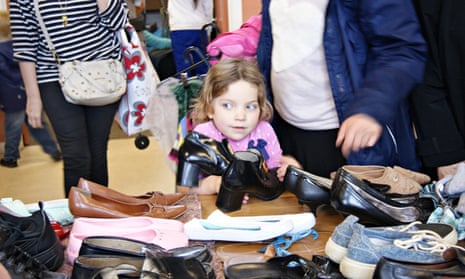10. Leeds Community Clothing Exchange
On exchange days, the queue usually snakes out the door. “We have to have four people on the front desk for the first couple of hours to cope with it all,” says Liz Barry, one of the long-time volunteers. “And then there’s finally a bit of a lull, just for an hour or so. And then it goes crazy again for the last hour. Such a great atmosphere!”
The Guardian’s product and service reviews are independent and are in no way influenced by any advertiser or commercial initiative. We will earn a commission from the retailer if you buy something through an affiliate link. Learn more.
The Leeds Community Clothing Exchange (LCCE) is such a simple and obvious idea that when you first hear it, you think, surely we must have been doing something like this for generations?
LCCE came about in 2007 when fashion designer and social enterpreneur Lizzie Harrison and a few friends were taking some clothes to the local charity and thought that they might have a look at each other’s stuff first. The Community Clothing exchange started small-scale there (in Lizzie’s design studio once a month) and then grew out of that space, and into the Woodhouse community centre.
You pay £3 on the door, explains Barry (she went along to one of the earliest exchanges, and then, like many others, just stayed. Once of the nicest things about the LCCE is the way that it has now grown away from founder Harrison and is sustained by its own group of passionate volunteers). “Then you can come to any of the exchanges; you bring your clothes to the front where they get checked in (they must be clean and in good condition), and we give you one credit per item. And then you head in and you can exchange that credit for whatever you find. Members can swap as many items as they have brought with them or have on credit - we keep track of this on our database. It’s very affordable – that was one of our main aims, to make fashion affordable to everyone.”
You can take up to 20 items to an exchange; clothes are counted and checked for quality (they must be clean and in good condition), and swappers are given one token credit per item. Members can swap as many items as they have brought with them or have on credit; the organisers keep track of this on a database.
Now that it’s in the community centre, LCCE has somehow turned into a community social event. “People turn up and just spend the whole afternoon there,” says Barry. “The atmosphere is always lovely – it’s an incredibly diverse group but there’s always loads of chat. I love it in the big communal changing room; people all comment on what everyone else is trying on.”
Due to the timing of the exchanges (there’s no exchange in August and the September one is after our project deadline), we can’t make it to one of the monthly exchanges, but an email out to members results in a flood of enthusiasm into our email box; people are desperate to talk about how much they love it. Among several very keen to get involved, Miriam Osner wrote: “I have been going for about 18 months. I think they are amazing. I have lost a lot of weight and would not have been able to afford to keep buying new clothes as I changed sizes, but thanks to the Exchange I have been able to come each month and swap my big sizes for smaller sizes and just pay £3 a month.” Sarah Hepworth praises “this amazing event”, and Rachel Wetton is so enthusiastic about the whole enterprise – “it’s fantastic!” – that she sends me pictures of some of the wonderful dresses she has got there over the years (“we all look out for the dresses”).
They’ve managed to include all sorts of sections of the local community. For example, members can donate spare credits into a pot for charities supporting vulnerable people such as a woman’s refuge or a centre for refugees. “And they can come down and choose clothes with everyone else; nobody needs to know who they are or that the credits have been donated,” explains Barry.
It’s not the answer (“when you work out what the answer is please tell me!” laughs Lizzie Harrison) to the incredibly complex problems of the modern fashion industry. Clearly it doesn’t begin to address working conditions, for a start. But it does provide one intelligent option for the problems at the other end of the supply chain, the 30% of clothing in the average household wardrobe that has not been worn for over a year, the 350,000 tonnes of clothing that go to landfill, according to Wrap. “I love the idea that the clothing you once loved is going to someone else who will love it too,” says Barry. “I like seeing people get that buzz of enjoyment from finding something they like, and I get immense pleasure from seeing someone else in my clothes. I remember a T-shirt that I put into the Exchange being picked up by this sixth-form boy, who put it straight on and just looked great in it.”
Is it transferable? Groups from other towns and cities have been in touch and volunteered with them to see how to set up something similar in their own areas. Harrison has now relocated to Bristol and another founder member has moved to Manchester, and both plan to look into getting new branches going there. “It’s incredibly pleasing,” says Harrison, “to see the way that it maintains itself now, that it has its own momentum.” There are other projects – subtly different – in other cities anyway; perhaps every city needs to find its own variety?
As I write this another email arrives in my inbox from a member, Barbara Martin: “I don’t enjoy clothes shopping, to me it feels soulless and everything is more expensive than I value them. At the clothes exchange I know I can get great quality clothes in a friendly community atmosphere for £3 entry, and there’s curry and cake so it’s a whole afternoon out. It is also a great way for me to keep in touch with people I might not always see, I often go alone and meet people I know all afternoon. They have clothed me through weight loss, a new job, parties and nights out. I don’t think I have a favourite thing, I just love the feeling when someone compliments me on an item and it’s from the exchange. It makes me feel like I’m winning at life and I know a secret that I want to share with everyone.”
The projects in this series:
1. The community supported farm
2. The bike repair co-operative
3. The community garden centre
5. The meat-rearing collective
7. The neighbourhood community scheme
8. The local beer-growing group
12. The repair cafe
16. The school growing project
17. The traffic reduction project
This article is part of the Live Better Community Project month. In September, we are showcasing 17 community projects from around the UK. We are asking you to vote for your favourite project. The project with the most votes will be awarded £1,000 of funding, and two runners-up will each receive funding of £500. One voter chosen at random will receive £150 worth of gift vouchers for Nigel’s Eco Store. Terms and conditions here.
With thanks to: 10:10; FOE; Project Dirt; Neighbourly; UK Community Foundations; Groundwork; Business in the Community; Federation of City Farms and Community Gardens; the Prince’s Trust; Garden Organic; the Royal Horticultural Society; the RSPB; Keep Wales Tidy; The Wildlife Trusts; and Mind.
Interested in finding out more about how you can live better? Take a look at this month’s Live Better challenge here.
The Live Better Challenge is funded by Unilever; its focus is sustainable living. All content is editorially independent except for pieces labelled advertisement feature. Find out more here.











Comments (…)
Sign in or create your Guardian account to join the discussion